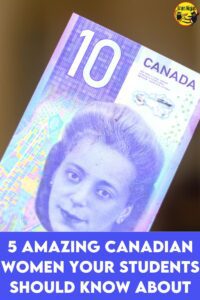
You don’t have to wait for Women’s History Month to learn about amazing Canadian women. There are so many creative, intelligent and trailblazing women in the world. I think many people don’t realize how many fascinating women we have in our own country. Come learn about these women that you can add to your lessons any time of year.
If you are looking specifically for books to use during Women’s History Month, check out our post, Books For and About Powerful Women.
Mary Two-Axe Earley
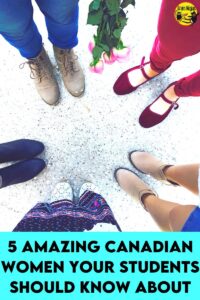
Mary Two-Axe Earley was a Mohawk woman born in 1911 on the Kahnawake reserve in Quebec, Canada. She was an Indigenous rights activist. Her actions and perseverance had a profound impact on Indigenous women’s rights in Canada. She tirelessly advocated against discriminatory laws that stripped Indigenous women of their status and rights if they married non-Indigenous men. Indigenous men who married non-Indigenous women did not lose their rights and status.
In the 1960s and 1970s, Earley led a national campaign against the injustices of the Canadian government’s discriminatory policies. Her activism raised awareness about the gender-based discrimination faced by Indigenous women. This led to significant legal changes. In 1985, the Canadian Parliament passed Bill C-31, amending the Indian Act to restore Indian status and treaty rights to thousands of Indigenous women and their children.
Mary Two-Axe Earley’s unwavering dedication and advocacy made her a symbol of justice within the Indigenous rights movement in Canada. She passed away in 1996.
Resources to Learn More About Mary Two-Axe Earley
Mary Two-Axe Earley: I Am Indian Again: This is a documentary film. Please preview it before showing it to your students so you can prepare students for the language and topic. I would recommend it for older students after you have done some work on Indigenous history.
Find Mary Two-Axe Earley Reading Comprehension Activities available on TpT ($USD) or our BN Shop ($CAN).
Elsie MacGill
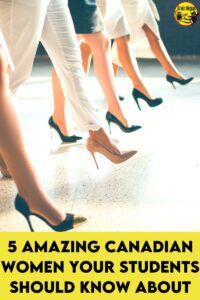
Elsie MacGill was born in 1905 in Vancouver, British Columbia. She was a groundbreaking Canadian aeronautical engineer and feminist whose life and achievements shattered gender barriers in the male-dominated field of aviation.
Her parents strongly believed in education for all their children. Attending university was very important. MacGill became the world’s first female aeronautical engineer in 1927 after earning her degree from the University of Toronto. Unfortunately, she developed polio. She used a wheelchair for a while. Elsie used that time to learn everything she could.
Elsie is called the “Queen of the Hurricanes.” During World War II, she oversaw the production of Hawker Hurricane fighter planes at the Canadian Car and Foundry Company. Under her leadership, the company became the first in the world to mass-produce aircraft under a woman’s supervision. MacGill’s expertise and ideas led to the development of safer and more efficient aircraft designs.
Her achievements have had a lasting impact on the aerospace industry and on gender equality. She inspires young girls to seek out science and math.
Resources to Learn More About Elsie MacGill
Find Elsie MacGill Reading Comprehension Activities available on TpT ($USD) or our BN Shop ($CAN).
Meet Elsie MacGill by Elizabeth MacLeod
Queen of the Hurricanes: The Fearless Elsie MacGill by Crystal Sissons
Viola Desmond
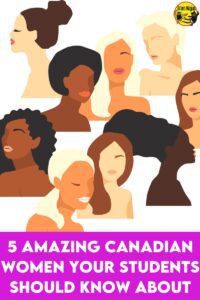
Viola Desmond was born in 1914 in Halifax, Nova Scotia. She was a Canadian businesswoman and civil rights activist whose life and achievements left a lasting mark on the fight against racial segregation and discrimination.
In 1946, Viola Desmond refused to leave a whites-only area in a movie theatre in Nova Scotia, Canada. The police forcibly removed and arrested her. Her stand against racial injustice inspired a nationwide civil rights movement. She was formally charged with tax evasion for not paying for the correct ticket. It would be in poor taste to criminalize her strictly for being in the whites-only section of the theatre. Her case got significant attention, leading to the dismantling of segregation laws in Nova Scotia in 1954. The charges followed her throughout her lifetime. Her legacy continued to echo throughout history. She became a symbol of the struggle for civil rights in Canada.
In 2018, the Canadian ten-dollar bill featured Viola Desmond. It was the first vertical bill, and she was the first Black Canadian and the first non-royal woman to appear on Canadian money.
Resources to Learn More About Viola Desmond
Meet Viola Desmond By Elizabeth MacLeod
Viola Desmond Won’t Be Budged by Jody Nyasha Warne
The Trailblazing Life of Viola Desmond: A Civil Rights Icon by Rachel Kehoe
Viola Desmond by Becky Noelle
Viola Desmond – A Woman’s Brave Stand Against Discrimination in Canada Canadian History for Kids True Canadian Heroes by Professor Beaver
Roberta Bondar
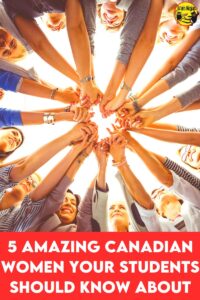
Roberta Bondar, born in 1945, is a Canadian astronaut, neurologist, and photographer. She made history as the first Canadian woman to travel to space. In 1992, she flew aboard the Space Shuttle Discovery as a payload specialist on Mission STS-42. During her mission, Bondar conducted many important experiments.
Bondar holds a Ph.D. in neuroscience and is a scientist, researcher, author, and speaker. She has been a vocal advocate for environmental conservation. She uses her photos to raise awareness about the natural world. Many of these photos can be seen in her book Touching the Earth.
Bondar’s journey into space and her dedication to scientific research and environmental causes have made her a role model for aspiring scientists and women in STEM fields. She is a leader in her field and inspires young girls daily.
Resources to Learn More About Roberta Bondar
Roberta Bondar: Canada’s First Woman In Space by Judy Wearing
The Famous Five
The Famous Five (also known as the Valiant Five) was a group of five Canadian women: Emily Murphy, Irene Parlby, Nellie McClung, Louise McKinney, and Henrietta Muir Edwards. They pioneered Canadian women’s rights activists and were suffragists in Canada during the early 20th century. It should be noted that they only advocated for white women’s rights.
Their biggest achievement was in 1929 when they launched the “Persons Case,” a legal challenge to determine if women could be considered “persons” instead of property under the British North America Act. If a woman could be determined to be a person, she would be eligible for appointment to the Canadian Senate.
After five years of legal battles, the case reached the Judicial Committee of the Privy Council in Britain. It ruled in favour of the Famous Five. This decision not only granted Canadian women the right to participate in politics but also established a legal precedent for equal rights. It meant further advancements in women’s rights in Canada (like the right to vote and the right to an education). The legacy of the Famous Five continues to inspire Canadian women.
Resources to Learn More About The Famous Five
The Famous Five Drama Circle is available on TpT ($USD) and our BN Shop ($CAN).
If you have never done a drama circle, you might benefit from using our How to Do A Drama Circle activity. It’s available in our Resource Library for our ninjas on our email list. If you’re not on the list yet, we can send it directly to your inbox when you sign up.

Canadian Women Now and Then: More than 100 Stories of Fearless Trailblazers by Elizabeth MacLeod
Famous Five: Five Canadian Women And Their Fight To Become Persons by Nancy Millar
Looking for More?
We are always looking for women to highlight, and while this post can only include five, we’re always inspired to write another one. If you know a Canadian woman the world should know about, tell us about her in the comments below.






